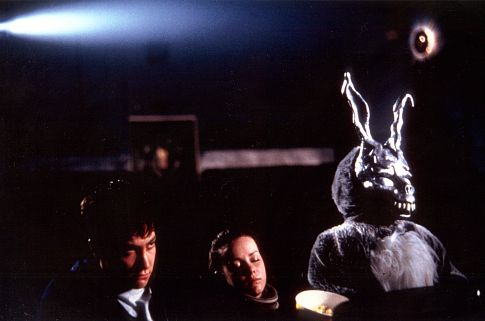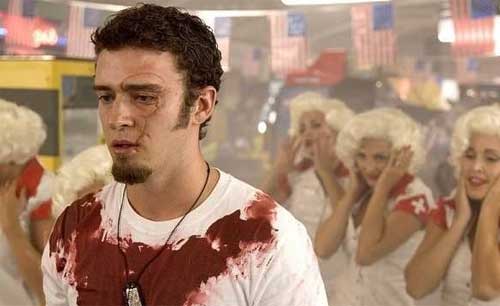Title: Godzilla Vs. Destroyah
Director: Takao Okawara
Released: 1995
Starring: Takuro
Tatsumi, Yoko Ishino, Yasufumi Hayashi, Megumi Odaka, Momoko Kochi, Kenpachiro
Satsuma
Plot: When Godzilla suddenly appears in Hong Kong with
strange lava like rashes, the Japanese Self Defence Force (JSDF) are quick to
launch into action as they fear that Godzilla’s body is going to meltdown.
Things only get worse when the effects of the reconstructed Oxygen destroyer
which killed the original Godzilla has now caused a colony of Precambrian
organisms to mutate into monstrous crab-like creatures, which soon bond
together to form the monstrous Destoroyah.
Review: Originally intended to be the last Godzilla film
until 2004 when the franchise would celebrate its 50th anniversary, the
news of Toho’s plans to kill off the company’s biggest export unsurprisingly
made news around the world when it was announced. These plans were also intended to provide the 1998
American remake a clean slate to work from and build their in their intended
trilogy. However as we all know now that remake would be greeted with much
disappointment from both fans and critics alike leading to the plans for an intended trilogy
being scrapped.
Unquestionably it is was a big responsibility that director
Okawara was tasked with here especially considering how beloved Godzilla is,
even despite the fact that he was still in his much more primal form which has
been one of the trademarks of the Heisei Era. Still having previously directed
one of the most profitable entries in the series “Godzilla Vs. Mothra” and its
follow up “Godzilla Vs. Mecha-Godzilla II” producers Tomoyuki Tanaka and Shogo
Tomiyama certainly felt he was up to the task. Unquestionably though if this film was to be the final Godzilla
film it certainly provided a suitably touching yet impressive end even if it
ultimately would only mark the end of the Heisei era. At the same time the film contains
a number of links to the original film, which not only sees Momoko Kochi reprising her role as Emiko
Yamane the daughter of Dr. Kyohei Yamane in the original “Godzilla” at the same
time his Grandson Kenichi (Hayashi) is also introduced here who as the resident
Godzilla expert despite being a student and essentially only being tempted by a
pretty face rather than you know saving the whole of mankind from being killed
by an exploding Godzilla which is stated is powerful enough to cause the
destruction of the entire planet, but hey whatever works right?
These links to the original film are not limited to key
characters though as despite Dr. Serizawa seemingly taking the secrets of the
Godzilla destroying “Oxygen Destroyer” to his grave in the first film, here it
has been created again and as with all fantastical discoveries it is not long
until an unwelcome side effect happens which being a Godzilla movie is in the
form of monsters, but more uniquely in this case is the fact that these
monsters start off small (well for Godzilla atleast) before mutating into a
much larger form….twice! As a result of these changing forms the monster action
is not only maximised with the smaller and more multiple form of Destroyah
taking on the military before mutating into his larger forms form some more
traditional city destroying action.
Destroyah is an impressive creation and more than a suitable
opponent for what was expected to be Godzilla’s final battle with the battle
ultimately requiring not only Godzilla, but also a now fully grown Manila and
the JSDF to take him out, arguably making his toughest opponent to date, though
by this same reasoning “King Ghidorah” would be considered tougher seeing how
it took he combined efforts of seven monsters in “Destroy All Monsters” to
defeat him. The battle with Destroyah though is unquestionably a tough one and
certainly one of the hardest Godzilla has had since he faced off against “Space
Godzilla” in the previous film.
Unquestionably it is ultimately a sad tone which overshadows
the film, especially as Godzilla here is shown to be slowly dying as his body
goes into meltdown, which also has the side effect of changing usual blue fire
breath into a striking shade of crimson and impressive lightning bolts running
down his spinal plates. Despite the efforts of the JSDF to prevent his meltdown
ultimately when his end comes it is a suitably emotional scene and one only heightened
by the score by Akira Ifukube. Okawara while he might be already handling a lot
of pressure in providing a suitable exit for Godzilla, but clearly not afraid of
taking a gamble he also kills of the now mature Baby Godzilla in a scene almost
as emotional as Godzilla’s own death as he Okawara somehow manages to find a
way to have this version of Godzilla still show the same amount of expression
that his Showa form had with his humanoid characteristics. True it might be
only a temporary death as Godzilla passes the torch of “King of Monsters” to his
son but ultimately it is a gamble which really pays off here.
While onscreen there might have been some emotional
goodbyes, this film would equally have some equally emotional ones behind
the scenes aswell as this film would be the last film to be produced by Tomoyuki
Tanaka, who since being responsible for the creating Godzilla had produced
every film in the series (aswell as every Sci-fi film produced by Toho) with
this film being his last before he sadly passed away two years later, with the
American remake being dedicated in his memory. At the same his fellow “Four
Fathers” member composer Akira Ifukube who most importantly was responsible for
giving Godzilla his trademark roar also chose to mark his retirement with this
film after being tempted back by producer Tanaka despite having handed over the
reins to fellow composer Takayuki Hattori on the previous film and while his
memorable themes would continue to live on in the films which followed, here his
final score is a powerful mixture of haunting music and heart breaking requiem
alongside his ever rousing marches
ensuring that he unquestionable end his career on a unquestionable high
note.
While this might not have been the finale it was originally planned
to be for the series it is still another memorable milestone in the saga before
director Okawara was brought back for one more turn in the director’s chair as he
ushered in the final (to date) era with “Godzilla 2000” which also marked the
start of the Millennium era. Unquestionably here though he provides one of the
more memorable films even without the prospect of Godzilla’s death, as this
film combines tight plotting and memorable action scenes to powerful effect and
ultimately ensuring that the Heisei era went out on a high.
Next Time: "Godzilla: Final Wars" - The Millennium era aswell as the franchise is brought to a close (for now atleast) with director Ryuhei Kitamura crafting a film he described as being a "Best of album" for the franchise and in many ways a modern reworking of the classic "Destroy all Monsters". Needless to say Godzilla was going to go out with a bang as memorable faces returned to do battle one final time.
Next Time: "Godzilla: Final Wars" - The Millennium era aswell as the franchise is brought to a close (for now atleast) with director Ryuhei Kitamura crafting a film he described as being a "Best of album" for the franchise and in many ways a modern reworking of the classic "Destroy all Monsters". Needless to say Godzilla was going to go out with a bang as memorable faces returned to do battle one final time.






















This is one of my favorite ones, not only because of Godzilla's death, but also because Destoroyah is an incredibly powerful villain. I love how he kept evolving all the time! First time I saw it I had no idea Godzilla actually died on this one so I was shocked! I also loved the idea that Godzilla was a walking time bomb, I mean there's so many cool elements to this film, it's certainly one of the best in the whole series.
ReplyDeleteBeing in the UK that surprise was always going to be spoiled, seeing how we got clips but no region 2 release like so many titles in the series, which only further justifies the investment in a multi-region DVD player.
DeleteYes it might be sad to see Godzilla's death but atleast its handled well and refuses to state that the series has reached its conclusion with the rise of a new Godzilla from the ashes.